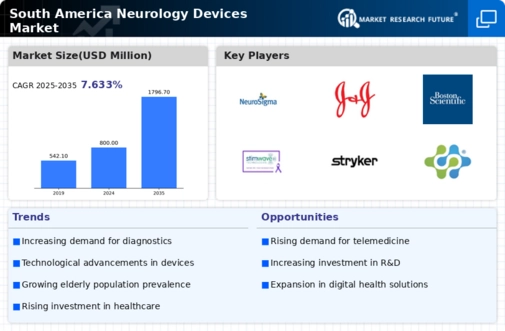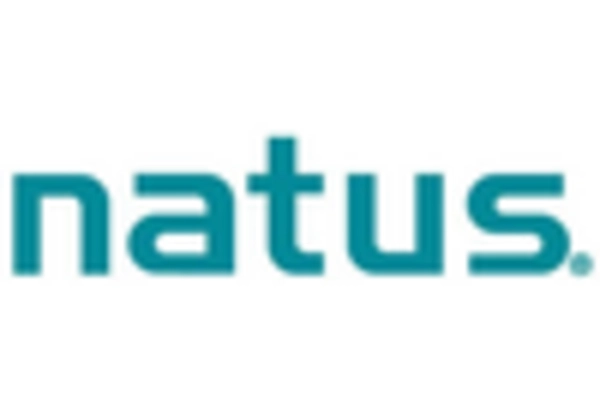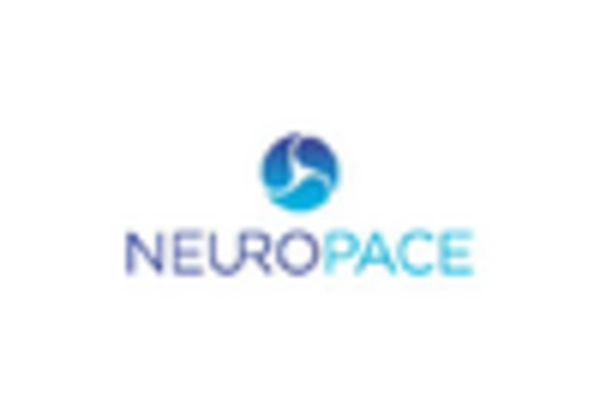Growing Aging Population
The increasing aging population in South America is a pivotal driver for the neurology devices market. As individuals age, they become more susceptible to neurological disorders such as Alzheimer's disease and Parkinson's disease. This demographic shift is expected to lead to a heightened demand for diagnostic and therapeutic devices tailored for these conditions. According to recent estimates, the population aged 65 and older in South America is projected to reach 12% by 2030. This trend suggests a significant market opportunity for manufacturers of neurology devices, as healthcare systems will need to adapt to the rising prevalence of age-related neurological issues. Consequently, the neurology devices market is likely to experience robust growth as stakeholders respond to the needs of this expanding demographic.
Increased Focus on Mental Health
The growing recognition of mental health issues in South America is influencing the neurology devices market. Mental health disorders, including depression and anxiety, are often linked to neurological conditions, prompting a more integrated approach to treatment. As awareness of mental health continues to rise, there is a corresponding demand for devices that can assist in the diagnosis and management of these conditions. For instance, neurostimulation devices are gaining traction as effective treatment options for various mental health disorders. The neurology devices market is likely to benefit from this trend, as healthcare systems increasingly prioritize mental health alongside neurological care. This shift may lead to a broader range of products being developed, catering to the diverse needs of patients.
Government Initiatives and Funding
Government initiatives aimed at improving healthcare infrastructure are significantly impacting the neurology devices market in South America. Various countries in the region are increasing their healthcare budgets to enhance access to medical technologies, including neurology devices. For example, Brazil has allocated approximately $1 billion for healthcare improvements, which includes funding for neurological research and device development. Such investments are likely to stimulate innovation and encourage local manufacturers to enter the neurology devices market. Additionally, public health campaigns focused on raising awareness about neurological disorders are expected to drive demand for diagnostic and therapeutic devices. This supportive environment may lead to a more competitive market landscape, fostering growth and development in the sector.
Technological Integration in Healthcare
The integration of advanced technologies into healthcare systems is transforming the neurology devices market in South America. Innovations such as artificial intelligence, telemedicine, and wearable devices are enhancing the diagnosis and management of neurological disorders. For instance, AI algorithms can analyze patient data to identify patterns indicative of neurological conditions, thereby improving early detection rates. Furthermore, the rise of telemedicine facilitates remote monitoring and consultations, making neurological care more accessible. As a result, the neurology devices market is witnessing an influx of new products that leverage these technologies, potentially increasing market penetration and improving patient outcomes. The overall market is expected to grow at a CAGR of 8% over the next five years, driven by these technological advancements.
Rising Incidence of Neurological Disorders
The rising incidence of neurological disorders in South America is a critical driver for the neurology devices market. Conditions such as stroke, epilepsy, and multiple sclerosis are becoming increasingly prevalent, necessitating advanced medical devices for effective management. Recent studies indicate that the incidence of stroke in South America has increased by 20% over the past decade, highlighting the urgent need for innovative treatment solutions. This trend is likely to propel the neurology devices market as healthcare providers seek to implement more effective diagnostic and therapeutic options. The growing burden of these disorders may also lead to increased collaboration between healthcare providers and device manufacturers, fostering advancements in technology and improving patient care.


















Leave a Comment